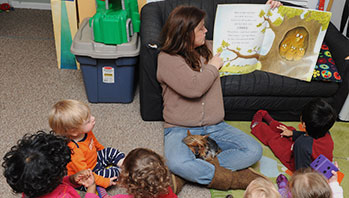- flow
- puddle
- river
- settle
- stream
MA Standards:
Reading for Informational Text/RI.P.MA.1: With prompting and support, ask and answer questions about an informational text read aloud.
Reading for Informational Text/RI.P.MA.7: With prompting and support, describe important details from an illustration or photograph.
Reading for Informational Text/RI.P.MA.10: Listen actively as an individual and as a member of a group to a variety of age-appropriate informational texts read aloud.
MA Draft STE Standards:
Earth and Space Sciences/Earth’s Systems/ESS2.C: Explore and describe the different places water is found in the local environment.
Earth and Space Sciences/Earth and Human Activity/ESS3.A: Engage in discussion and raise questions using examples about how humans use local resources (e.g., soil, water) to meet their needs. [Cause and Effect]
Head Start Outcomes:
Literacy Knowledge/Book Appreciation and Knowledge: Asks and answers questions and makes comments about print materials.
PreK Learning Guidelines:
English Language Arts/Reading and Literature 6: Listen to a wide variety of age appropriate literature read aloud.
English Language Arts/Reading and Literature 10: Engage actively in read-aloud activities by asking questions, offering ideas, predicting or retelling important parts of a story or informational book.
Read Together: A Cool Drink of Water #1

© Commonwealth of Massachusetts, Department of Early Education and Care (Jennifer Waddell photographer). All rights reserved.
STEM Key Concepts: Water is a natural resource; Water is a basic need for all living things; You can use different objects to move water
ELA Focus Skills: Active Listening, Story Comprehension (Main Idea), Make Connections, Vocabulary
Before You Read
Show children the cover of A Cool Drink of Water and have them locate the title. Read the words aloud, tracking them as you do.
Hold up the cover of the book and ask children what they think the boy is doing in the picture. Elicit that he is getting a drink of water. Review with children that water is one of the basic needs of all living things. (You may want to review what children learned last week about the basic needs of plants.) Say,
- All living things need water, including people. People all around the world need water. We get the water we need from many different places and in many different ways. Let’s read and find out where some people get the water they need.
As You Read
Read slowly. Hold the book so everyone can see each of the photographs clearly.
- Pause on a few spreads and have children identify where the water in each spread comes from. (pond, river, well, rain drops, fountain, etc.) For example, on the first spread, ask, Where is the man getting the water from?
- Pause on the back cover. Ask, Have you ever gotten water from a faucet like these boys? Do you know where the water that comes out of the faucet comes from?
- Use the photographs to clarify the meaning of words they may use during the week such as river, flow, puddle, pump, settle, stream, and bottle.
After You Read
Talk about the book with children. Ask questions such as,
- Have you ever gotten water from any of the places we read about?
- How do you get water to drink?
- Where do you think the water we drink at school comes from?
- Did you like this book? What was your favorite part?
English Language Learners: Help children understand the multiple meanings of the word pump. Say, The word pump can mean “to push up and down” (act out the meaning of the word as you say it) or “a machine that pumps” (show a pump or a picture of a pump). Use each word in a new sentence and have children tell you which meaning they think is being used. Have children act out the meaning when it is used as a verb and point to the pump when it is used as a noun.
Take It Further: Talk with children about where their water comes from. You may need to do some research to find where your local water supply originates (contact your town or city’s municipal departments to learn more). Talk about how the water gets to children’s homes and your learning center. If possible, schedule a field trip to visit the source of your local water supply to explore where their water comes from. Have them describe the environment where the body of water is found.
